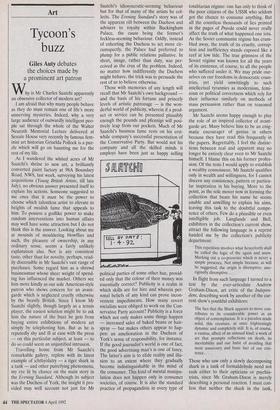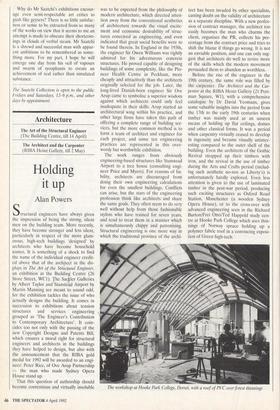Art
Tycoon's buzz
Giles Auty debates the choices made by a prominent art patron
Why is Mr Charles Saatchi apparently an obsessive collector of modern art?
I am afraid that why many people behave as they do must remain one of life's more unnerving mysteries. Indeed, why a very large audience of outwardly intelligent peo- ple sat through the whole of the Walter Neurath Memorial Lecture delivered at Senate House very recently by famous fem- inist art historian Griselda Pollock is a puz- zle which will go on haunting me for the rest of my life.
As I wandered the whited acres of Mr Saatchi's shrine to new art, a brilliantly converted paint factory at 98A Boundary Road, NW8, last week, surveying his latest acquisitions (Young British Artists, till late July), no obvious answer presented itself to explain his actions. Someone suggested to me once that it must be the power to choose which talentless artist to elevate to heights of modish fame that appeals to him. To possess a godlike power to make random interventions into human affairs may well have some attraction but I do not think this is the answer. Looking about me at mounds of mouldering blowflies and such, the pleasure of ownership, in any ordinary sense, seems a fairly unlikely explanation also. Nor is any consistent taste, other than for novelty, perhaps, read- ily discernible in Mr Saatchi's vast range of purchases. Some regard him as a shrewd businessman whose sheer weight of spend- ing has influenced the market. Others see him more kindly as our sole American-style patron who shows concern for an avant- garde which is neglected cruelly otherwise by the beastly British. Since I know Mr Saatchi slightly, though largely as a tennis player, the easiest solution might be to ask him the nature of the buzz he gets from buying entire exhibitions of modern art simply by telephoning him. But as he is reputedly shy and ill at ease with the press — on this particular subject, at least — to do so could seem an unjustified intrusion.
Travelling home from Mr Saatchi's remarkable gallery, replete with its latest example of ichthyolatry — a tiger shark in a tank — and other putrefying phenomena, my eye lit by chance on the main story in the Evening Standard. Although its subject was the Duchess of York, the insight it pro- vided may well account not just for Mr Saatchi's idiosyncratic-seeming behaviour but for that of many of the artists he col- lects. The Evening Standard's story was of the apparent rift between the Duchess and .advisers to royalty within Buckingham Palace, the cause being the former's feckless-seeming behaviour. Oddly, instead of exhorting the Duchess to act more cir- cumspectly, the Palace had preferred to plump for a public relations palliative. In short, image, rather than duty, was per- ceived as the crux of the problem. Indeed, no matter how indifferently the Duchess might behave, the trick was to persuade the rest of us to believe otherwise.
Those with memories of any length will recall that Mr Saatchi's own background — and the basis of his fortune and princely levels of artistic patronage — is the won- derful world of publicity, wherein if a prod- uct or service can be presented plausibly enough the pounds and pfennigs will posi- tively leap from our pockets. Much of Mr Saatchi's business fame rests on his erst- while company's successful presentation of the Conservative Party. But would not his company and all the skilled minds it employs have been just as happy selling political parties of some other hue, provid- ed only that the colour of their money was essentially correct? Publicity is a realm in which skills are for hire and wherein per- sonal beliefs of any kind can prove incon- venient impediments. How many covert socialists were obliged to work on the Con- servative Party account? Publicity is a force which not only makes some things happen — increased sales of baked beans or hair- spray — but makes others appear to hap- pen: an amelioration in the Duchess of York's sense of responsibility, for instance. If the good journalist's world is one of fact, the good advertising man's is one of fancy. The latter's aim is to elide reality and illu- sion to an extent where they gradually become indistinguishable in the mind of the consumer. This kind of mental manipu- lation does not happen only in consumer societies, of course. It is also the standard practice of propagandists in every type of totalitarian regime: one has only to think of the poor citizens of the USSR who seldom got the chance to consume anything. But all the countless thousands of lies printed in the pages of Pravda could never really affect the truth of what happened one iota. As the Soviet communist regime has crum- bled away, the truth of its cruelty, corrup- tion and inefficiency stands exposed like a reef at low tide. The true grimness of the Soviet regime was known for all the years of its existence, of course, to all the people who suffered under it. We may pride our- selves on our freedoms in democratic coun- tries, yet yield unwittingly to such intellectual tyrannies as modernism, femi- nism or political correctness which rely for their influence similarly on methods of mass persuasion rather than on reasoned argument.
Mr Saatchi seems happy enough to play the role of an inspired collector of avant- garde art. Many believe him to be an enig- matic encourager of genius in others because they have read this frequently in the papers. Regrettably, I feel the distinc- tions between real and apparent may no longer be entirely clear even to Mr Saatchi himself. I blame this on his former profes- sion. Of the tests I would apply to establish a wealthy connoisseur, Mr Saatchi qualifies only in wealth and willingness, for I cannot discern any consistency, pattern or particu- lar inspiration in his buying. More to the point, as the sole mover now in forming the collection that bears his name he seems unable and unwilling to explain his aims, leaving this task to the doubtful compe- tence of others. Few do a plausible or even intelligible job. Langlands and Bell, exhibitors in the collection's current show, attract the following language in a reprint handed me by the collection's publicity department:
This repetition involves what henceforth shall be called the logic of the again and anew. Marking out a co-presence which is never a simple presence. Not simple because, as will be suggested, the origin is diremptive: ano- riginally diremptive....
In flight from such language I turned to a text by the ever-articulate Andrew Graham-Dixon, art critic of the Indepen- dent, describing work by another of the cur- rent show's youthful exhibitors:
The fact that the Shark appears to move con- tributes to its considerable power as an object of contemplation. It is a paradox made solid, this creature, at once frighteningly dynamic and completely still. It is, of course, a vanitas, albeit of an unusual kind: a work of art that prompts reflections on death, its inevitability and our habit of avoiding that most unsavoury and basic fact of our exis- tence... .
Those who saw only a slowly decomposing shark in a tank of formaldehyde need not rush either to their opticians or psychia- trists, since Mr Graham-Dixon is merely describing a personal reaction. I must con- fess that neither the shark in the tank, which is not a work of art, nor another of this particular young man's creations, 'One Thousand Years' (blowflies, maggots, cow's head, insectocutor etc.), which is not a work of art either, prompted any thought of death in me, unless it be by boredom.
Nor are rows of cabinets full of discarded pills and potions, by the same artist, works of art, though they may cause other critics than I to contemplate anything from haem- orrhoids to hot flushes. One of the major purposes of what was once considered a sound education is that it dissipates the attractions exercised by superficial thinking and writing: its recipient is encouraged to learn how to think clearly. Calmness and clarity of thought are the most potent weapons for cutting through inflated claims of any kind, whether they are found in advertising copy, art reviews or feminist oratory. A basic interest in and instinct for the truth arms us against hustling of all kinds. A person so armed may never be particularly popular or powerful and would probably prefer to end up on the side of angels rather than of Engels. Such a person is never a member of a modish mob.
The current exhibition at the Saatchi Collection purports to introduce the bright- est of young British hopefuls to an admir- ing audience. The first time I was told about the most publicity-conscious of their number, I understood his name to be Damien Hearse. As possessor of what AndrewGraham-Dixon describes as a `single-minded morbidity', Mr Hirst should at least consider my recommendation for a new surname. The college at which he studied — Goldsmith's — trains its young artists in the manipulation of publicity. Clearly Mr Hirst has absorbed his lessons very well and is already a minor star of the avant-garde firmament in consequence. Mr Saatchi, like Graham-Dixon, cannot but see more in Mr Hirst's festering displays than I do. Possibly both hope to discover the meaning of life from contemplation of foetid fish or fly-blown skulls. I should admit here that if I were seeking a philo- sophical guru, I doubt I would be scouring the ranks of immature former art students — but then my tastes in art seem different from theirs, too.
What of the other exhibitors? John Greenwood also seeks to say something significant, but through surrealist similes. His complex, organic constructions are drawn and painted carefully and may well be autobiographical: metaphors for roman- tic mishaps in bedsit land. Alex Landrum, by contrast, paints single-colour canvases which conceal, quite cleverly, the names given by the manufacturers to the house- hold paints he uses. The process used resembles simple blind-embossing but moves the critic Sarah Kent, who has writ- ten the exhibition catalogue, to ecstasies of philosophising: 'The proportions of his can- vases are derived from old master paintings so as, subliminally, to affirm their status as artworks....
Why do Mr Saatchi's exhibitions encour- age even semi-respectable art critics to gush like geysers? There is so little satisfac- tion or sense to be extracted from so many of the works on view that it seems to me an attempt is made to obscure their shortcom- ings in clouds of verbal steam. Mr Saatchi is a shrewd and successful man with appar- ent ambitions to be remembered as some- thing more. For my part, I hope he will emerge one day from his veil of vapours and swarm of sycophants to create an achievement of real rather than simulated substance.
The Saatchi Collection is open to the public Fridays and Saturdays, 12-6 p.m., and other days by appointment.




























































 Previous page
Previous page